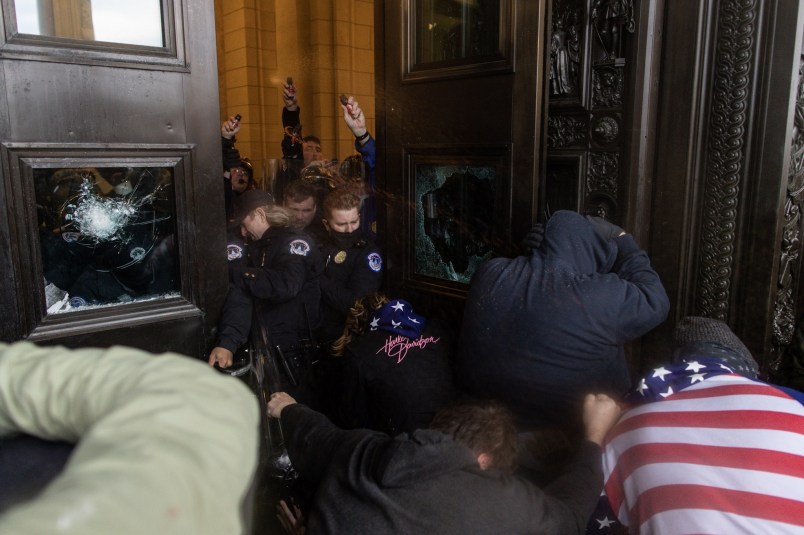During the Jan. 6 Capitol breach, when officers from Washington, D.C’s Metropolitan Police Department came to help the overwhelmed U.S. Capitol Police, something interesting happened: MPD started using the types of “less-lethal” weapons than the Capitol Police had been barred from using and rioters… started leaving.
“When MPD heroically showed up, came to our help, when some of their officers started using the various sting balls, it was reported to us that individuals were turning around leaving,” Michael Bolton, the inspector general for the Capitol Police, testified Thursday.
“They’re very painful, these types of munitions.”
The revelation that Capitol Police officers were restricted in the types of “less-lethal” munitions they were allowed to use on Capitol rioters was just one of the details from Bolton’s ongoing investigatory work that he discussed before the Committee on House Administration Thursday.
Between expired munitions, some riot shields that simply broke apart when used, a shortage of back-up supplies and the order restricting how Capitol Police could respond to rioters, law enforcement was hindered in effectively protecting the Capitol, Bolton testified.
“It’d be very difficult to say ‘It would have absolutely turned the tide,'” Bolton said, asked if being allowed to use more “less-lethal” munitions would have prevented the breach. “But it certainly would have given them a better chance at doing what they needed to do.”
The committee released executive summaries of two “flash” reports from Bolton ahead of his testimony, and Bolton and committee members also quoted and discussed material from “law enforcement sensitive” portions of those reports that have not been released publicly. (Bits of the non-public material have been leaked to reporters.)
Bolton said that an assistant deputy chief in the Capitol Police, who he did not name, gave the order not to use certain “less-lethal” weapons because they could cause life-altering injury or death if they were misused. Committee chair Zoe Lofgren (D-CA), in her questions to Bolton, specified that in addition to stinger balls, Capitol Police officers had been instructed not to use certain types of grenade launchers that can carry less-lethal munitions.
In addition to discussing failures of intelligence-dissemination and preparation on behalf of Capitol Police, much of Bolton’s testimony focused on the actual equipment Capitol Police officers were using, and the officers — or lack thereof — who were in a position to respond effectively on Jan. 6.
“Three grenadiers is not adequate,” Bolton said at one point in response to questions from Rep. Teresa Leger Fernand (D-MN). “That’s an easy one. We don’t have enough of that. Certainly, there needs to be more trained and properly equipped people who can use that equipment effectively and safely.”
Later, Lofgren returned to a Bolton’s investigation of equipment failures, noting at one point that certain riot shields “shattered upon impact,” and that some less-lethal munitions were beyond their expiration date.
In one case, Lofgren said, the inspector general found that a Civil Disturbance Unit in the Capitol Police had to respond to the Jan. 6 crowd without their riot shields — because the door on a bus carrying shields was locked.
Lofgren also revealed the stunning detail that “civilian” Capitol Police employees had been tasked — mid-insurrection — with delivering supplies to officers.
“You also reported that officers experienced supply constraints during the insurrection, and as a result, unarmed and unescorted civilian employees were sent to deliver less-than-lethal munitions to officers, but they were hindered by crowd and, fearing for their safety, they left their vehicle and retracted,” the chairwoman said, reading from a document before her.
“There were civilians that were placed in that,” Bolton confirmed.
“To correct something like that, we strongly would recommend that they have pre-positioned additional munitions in a secure location within the capitol when you have these events, [so] that you don’t have to go out and get civilians to come in there and re-supply you,” he added.







Bolton wanted to emphasize that despite any shortcomings in preparation, all officers did have one bullet in their shirt pocket.
Trump Industries issued a press statement stating total confidence in the ammunition and shields they supplied on their no-bid contract, and blamed any supply or quality control problems on Hillary Clinton.
Civilians delivering supplies meant for police through a violent crowd.
What could go wrong? s/
This fits with earlier reporting that one of the reasons the National Guard wasn’t called in sooner is that they wanted to avoid a repeat of the bad optics from the previous summer’s protests. Zero threat recognition ability.
Wow. Seems like someone(s) let the CP down over the years. Hopefully this is the wakeup call that will protect the Congress from more seditious nonsense?